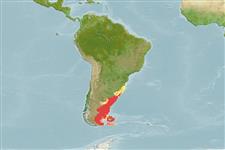>
Scombriformes (Mackerels) >
Stromateidae (Butterfishes)
Etymology: Stromateus: Greek, stromatos = a fish flattened body with a lot of colours (Stromateus sp.) (Ref. 45335).
More on author: Fowler.
Environment: milieu / climate zone / depth range / distribution range
Ecología
marino bentopelágico; rango de profundidad 22 - 133 m (Ref. 36453), usually ? - 100 m (Ref. 36453). Subtropical; 26°S - 55°S, 69°W - 48°W
Southwest Atlantic: southern Brazil to Tierra del Fuego, Argentina.
Tamaño / Peso / Age
Maturity: Lm ? range ? - ? cm
Max length : 38.0 cm NG macho / no sexado; (Ref. 36453)
Short description
Claves de identificación | Morfología | Morfometría
Espinas dorsales (total) : 0; Radios blandos dorsales (total) : 47 - 56; Espinas anales: 0; Radios blandos anales: 40 - 48; Vértebra: 43 - 46. Body blue green dorsally, silvery white ventrally. Many round dark blue spots on upper half of body. Distal parts of fins darker (Ref. 27363).
Spawns near the coast (Ref. 36453). Juveniles lives in close association with jellyfishes (Ref. 36453).
Life cycle and mating behavior
Maturities | Reproducción | Spawnings | Egg(s) | Fecundities | Larva
Menni, R.C., R.A. Ringuelet and R.H. Aramburu, 1984. Peces marinos de la Argentina y Uruguay. Editorial Hemisferio Sur S.A. Buenos, Aires, Argentina. 359 p. (Ref. 2806)
IUCN Red List Status (Ref. 130435)
Threat to humans
Harmless
Human uses
Pesquerías: sin interés
Herramientas
Special reports
Download XML
Fuentes de Internet
Estimates based on models
Preferred temperature (Ref.
123201): 5.6 - 14.6, mean 8.5 °C (based on 224 cells).
Phylogenetic diversity index (Ref.
82804): PD
50 = 0.6250 [Uniqueness, from 0.5 = low to 2.0 = high].
Bayesian length-weight: a=0.00891 (0.00507 - 0.01567), b=3.17 (3.01 - 3.33), in cm total length, based on LWR estimates for this species & (Sub)family-body (Ref.
93245).
Nivel trófico (Ref.
69278): 3.3 ±0.38 se; based on food items.
Resiliencia (Ref.
120179): Alto, población duplicada en un tiempo mínimo inferior a 15 meses (Preliminary K or Fecundity.).
Fishing Vulnerability (Ref.
59153): Moderate vulnerability (36 of 100).
Nutrients (Ref.
124155): Calcium = 71.8 [31.7, 143.6] mg/100g; Iron = 1.03 [0.50, 1.87] mg/100g; Protein = 15.7 [13.8, 18.3] %; Omega3 = 0.368 [0.232, 0.576] g/100g; Selenium = 33.8 [18.4, 67.8] μg/100g; VitaminA = 21.1 [7.8, 56.4] μg/100g; Zinc = 0.79 [0.55, 1.12] mg/100g (wet weight); based on
nutrient studies. 